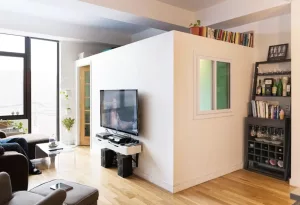Flex Wall Installation and Price Guide in New York (2024)
Go Back To Previous PageA flex wall, a temporary wall, can be a great way to partition your apartment. They aren’t costly but can be tricky to install, as you need landlord approval to put one up.
Recent college graduates and young professionals often search for affordable apartments. Newcomers to New York City also look for budget-friendly living spaces. They all want options that fit their tight budgets. There are various ways New Yorkers can make smaller apartments comfortable for roommates, and one popular method is to use temporary walls to divide the living space.
These temporary walls, also known as flex walls, can include partial walls, bookshelf walls, or temporary pressurized walls, providing privacy in a shared living space.
What Is a Flex Wall?
A temporary pressurized wall, also known as a “flex wall,” is a non-permanent wall that extends from floor to ceiling without being permanently affixed.
Unlike a traditional wall, it is designed not to interfere with an apartment’s ventilation, sprinkler system, or means of egress (exits). In recent years, New Yorkers have used temporary pressurized walls as high-class room dividers.
apartment’s ventilation, sprinkler system, or means of egress (exits). In recent years, New Yorkers have used temporary pressurized walls as high-class room dividers.
As per the Department of Buildings (DOB), a temporary wall must be non-load-bearing. This means the wall does not support the ceiling or any significant structural weight. According to the NYC Housing Maintenance Code, when installing a temporary pressurized wall, you must ensure the following:
- Please take note of the following requirements:
- Each bedroom must have a minimum of 80 square feet.
- The living room must be larger than the minimum required space.
- If a temporary wall is installed, it must not damage the permanent wall and should not require nails, screws, etc.
- Each room must have a window that faces outside to allow for natural light and ventilation.
- There must be a means of escape in case of an emergency.
- Pass-through bedrooms are not allowed when constructing a temporary pressurized wall.
Overall, pressurized walls have all the benefits of actual walls but are temporary, making them an ideal solution for loft spaces and apartments.
What Is a Partial Wall?
A partial wall is a temporary and often necessary compromise for buildings that do not allow pressurized walls. Like pressurized walls, partial walls are installed without screws or nails. They typically stop about 12 inches from the ceiling as New York City law and the landlord require.
Unlike an entire wall, a partial wall will have an opening instead of a door, which may require some creativity to ensure privacy.
What Is a Bookshelf Wall?
Bookshelf walls are popular for New Yorkers who want to create extra rooms or sections and additional storage space. A bookshelf wall is a temporary wall with attached shelving. These are popular for several reasons: 1) they provide a way to divide the apartment, 2) they offer extra storage space for books and decorations, and 3) they add interest to the decor.
Both options can transform a one-bedroom apartment into a two-bedroom apartment, and so on. However, only a pressurized wall attaches to the ceiling and has the look and feel of an actual wall. Another benefit is the added privacy they provide.
How Much Does a Flex Wall Cost in NYC?
Installing a flex wall in NYC can cost between $1,000 and $3,500. The final price depends on factors such as the size, type, height, and any customizations. Additionally, add-on features are available, and you can choose from various door styles with windows and types of temporary walls.
- sliding, pocket,
- standard, and
- single- or double-pane French doors)
Flex walls are usually about 5 inches thick and can support up to 30 pounds. However, you can reinforce the wall to mount heavier objects like a flat-screen TV. You can also customize a temporary pressurized wall with exceptional soundproofing to make it resemble a permanent wall.
Prefabricated walls, which have seams, are cheaper and can be installed more quickly. However, remember that seamless walls blend better with permanent walls and give a more polished look. It’s important to note that the temporary wall will typically be painted white unless you request and pay for a custom color.
You will usually need to provide the company with the paint, and they will handle the rest.
How to Build a Flex Wall
1. Ask Your Landlord for Permission
Please remember to get your landlord’s permission. Review NYC laws about temporary walls. Contact Flex Wall installation companies.
Decide if you want to buy or rent the wall. Check if you need approval from the DOB. Finally, schedule your installation.
2. Review NYC Laws on Temporary Walls
I would like you to familiarize yourself with the local laws regarding temporary walls. Before installing a flex wall, review the legal aspects and DOB regulations.
3. Call Up Flex Wall Installation Companies
Next, it’s time to explore your options with a few companies to understand the cost and options that fit your budget. Using a reputable company specializing in flex wall installation is best. It would be best if you were prepared to pay between $1,000 and $3,500, depending on your needs.
The pricing can vary depending on the size, type of materials (such as soundproofing), ceiling height, and level of customization requested.
4. Decide on Buying vs Renting Your Wall
You can lease some walls for up to three years or yearly with renewal fees. However, consider purchasing the wall outright, especially if you plan to stay in the apartment long-term. Please ensure you have clear documentation explaining the process and cost (if applicable) for taking the wall down and whether you must leave a security deposit if you lease the wall. Also, it is transparent how much notice may be needed for the company to take down the wall.
5. Check if You Need Approval from the DOB
After hiring a company to install your flex wall, you must notify your landlord and check if you need to submit plans to the Department of Buildings (DOB) for approval.
If approval is required, the installation company must submit plans and wait for approval before beginning work.
6. Schedule Your Installation
Once the wall is approved, please work with the building to reserve the service elevator, if available. Have your payment ready, as required, on the installation day. Remember that unless your apartment is vacant before you take possession and begin your occupancy, you may have to wait until you’ve moved in to install the wall.
So, ensure that the areas are clear.
Flex Walls vs. Real Walls
Remember that, according to New York City building codes, if you or your landlord wants to install a temporary pressurized wall, your landlord will need to obtain the necessary permits and get a new Certificate of Occupancy from the NYC Department of Buildings.
A Certificate of Occupancy, or a CO, is a document issued by the NYC DOB to certify that the building or apartment complies with the relevant building codes and is safe for its intended use. Usually, COs are issued after the fire marshal inspects the building or apartment and has undergone an electrical inspection.
As a result, landlords must have a registered architect or professional engineer submit the plans to the Department of Buildings. It’s important to note that the wall can only be installed once the DOB issues a permit.
Because of the lengthy process, many NYC landlords and management companies avoid allowing temporary walls.
However, if you’re considering adding additional rooms to your apartment, it’s a good idea to check with management and your real estate agent before signing a new lease. You might be able to negotiate the installation of a temporary wall, especially if you’re signing a longer lease.
According to Mike Circea of Holsper, understanding these legal requirements is crucial for avoiding costly fines and ensuring safety. He notes that choosing the right wall solution can add functionality and privacy while staying compliant.
Please remember the following information:
Please don’t try to install a wall without permission. This is an illegal conversion. According to the DOB, “Illegal conversions are living spaces altered to allow additional occupancy without DOB approval or adequate life-safety protections.
These units often lack at least two exits, proper windows, or good ventilation. They may also have unsafe and illegal gas, electrical, and plumbing systems.
Overall, converting living spaces within an NYC apartment is illegal and can result in several fines by the DOB. If you fail to obtain your landlord’s approval before installing, this action could also violate your lease.
What Is the Procedure for Getting a Temporary Pressurized Wall Installed in NYC?
In 2005, two firefighters tragically died in a New York City fire because the pressurized walls in the apartment were not indicated on the floor plan filed with the DOB. As a result, the firefighters became disoriented while trying to extinguish the fire. This incident led to the evaluation of pressurized walls by the New York City DOB, and new regulations were implemented in the housing maintenance codes. Consequently, some landlords are now cautious about allowing temporary pressurized walls.
Instead, they are more likely to approve partial and bookshelf walls, as these require less approval from the DOB. Suppose your landlord allows partial walls or bookshelf walls.


